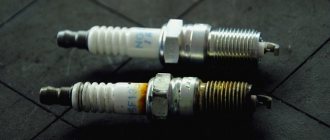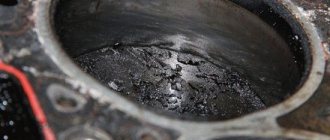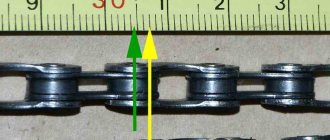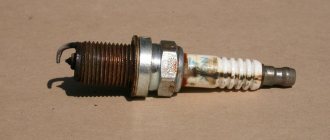Experienced motorists can often determine the type of engine problem by looking at the spark plug. If you find carbon deposits on your spark plugs, the reasons for this may vary and depend on its color. The fuel mixture interacts with oxygen in a special way during malfunctions.
Changes can have various reasons:
- excessive mixture consumption
- excessive amount of additives in the mixture
- Excessive oil consumption, malfunction of oil seals
- valve failure
- engine detonation
- use of unsuitable fuel
- early ignition
- oil ring failure
What does the color of spark plugs mean?
When the engine is in good working order, the spark plug insulator has a color ranging from coffee to light brown. Also, there should be no oil or gasoline on the surface.
If the color is different from that described above or we see additional plaque, then you should carefully consider this problem and diagnose the engine’s operation at a service station.
There are the following types of carbon deposits on spark plugs:
- red
- black
- white
- erosive plaque
- ash deposit
- traces of gasoline
- traces of oil
Experts often recommend paying attention to the color of the spark plug after a long run (about 10 thousand km).
A specific coating may appear if you turn on the engine in low temperatures. The appearance of changes is caused by the fact that the mixture is further enriched. Interruptions during start-up at low temperatures do not always indicate a breakdown. It is possible to say for sure about the presence of breakdowns only after the mileage.
How to properly service spark plugs
If you have driven more than 30-40,000 kilometers on the same spark plugs, then even with a working ignition system, they will begin to act up. Plaque and iron oxide form on the electrodes, preventing the formation of a spark. In addition, when the metal burns out, it increases the distance between the electrodes, which complicates sparking.
Typically, spark plugs are replaced after long-term use, but in some cases their service life can be extended. To do this, just clean the contacts. But if you just clean the carbon deposits, the effect may be negative due to an increase in the gap between the electrodes.
You can restore the nominal gap by bending the upper electrode of the spark plug, monitoring it using a special probe.
You should also pay attention to the condition of the insulators. If the insulator has cracks or other mechanical damage, the spark plug must be replaced. The presence of oil and dirt on the insulator is unacceptable. This reduces the effectiveness of the insulator, reducing resistance to electrical current. Its surface must be cleaned.
If the surface of the insulator is covered with an oil coating, then it is possible that the spark plugs are not screwed in tightly. They need to be unscrewed, the seats, contacts, insulators must be cleaned and screwed in again using a torque wrench. Table 1 shows torque values depending on the type of spark plugs and head material.
| Flat Fit Spark Plug (with Seal) | Tapered Fit Spark Plug | |||||
| Cylinder head material | Thread diameter | Thread diameter | ||||
| 18 mm | 14 mm | 12 mm | 10 mm | 18 mm | 14 mm | |
| Cast iron head | 35-45 Nm | 25-35 Nm | 15-25 Nm | 10-15 Nm | 20-30 Nm | 15-25 Nm |
| Aluminum head | 35-40 Nm | 25-30 Nm | 15-20 Nm | 10-12 Nm | 20-30 Nm | 10-20 Nm |
Black soot
One common type is black carbon deposits on spark plugs. In this case, the surface is covered with a velvety black coating. It is worth paying attention to the structure of the candle with black soot. Most often this occurs due to an excessively rich fuel mixture entering the engine.
The most common reasons why black soot appears on spark plugs include:
- the air filter is clogged and not enough oxygen is supplied to the engine;
- the carburetor or injector is faulty;
- low compression ratio;
- broken or defective spark plug;
- breakdown of the fuel pressure regulator;
Causes of black soot
Causes of black carbon deposits on spark plugs
A frequent question from owners of the VAZ-2114 car is, why does black carbon appear on the spark plugs? And the reason for its appearance is an increased level of gasoline in the air-fuel mixture.
This is due to the following factors:
- Malfunction or incorrect setting of the carburetor (on a VAZ-2114 it is a very rare occurrence to encounter a carburetor);
- The air filter is clogged and requires cleaning or replacement;
- Malfunction of the engine fuel regulators, resulting in increased fuel supply;
- Reduced compression level (cylinder pressure);
- Spark plug faulty.
Also, problems may arise if oil pores are deposited on the spark plug due to its penetration into the combustion chamber.
Diagnostics of VAZ-2114 engine operation
First of all, in case of engine malfunction, i.e. If it does not start, you need to check the spark plugs.
If black carbon deposits are detected during the inspection, first of all you need to find out the nature of its manifestation, what caused it, excess gasoline or oil, or perhaps just a weak spark of a spark plug.
Soot, in turn, is of two types:
- Oily . It appears in the places of threaded connections and in particular on the electrode itself, and also causes the appearance of blue smoke instead of standard exhaust gases.
Oil deposits on spark plugs
For full diagnostics, new spark plugs are used. After installing them, the car should travel 100-150 kilometers , based on further indicators of the spark plugs, it is already possible to judge the presence of malfunctions.
White soot
If there is white soot on the spark plugs, then we may be talking about an excessively lean fuel mixture entering the engine. A lean mixture can lead to overheating and damage to the exhaust valves. On spark plugs, white soot is only a consequence.
You can pay close attention to the shade of the plaque. A white coating on the spark plugs without a glossy sheen may indicate that low-quality fuel has been poured into the gas tank. The problems that caused such burning often disappear when changing gasoline.
If there is a glossy tint, we can talk about possible engine overheating.
White coating on candles appears for the following reasons:
- lunch mixture
- excessive air flow into the intake manifold
- cooling failures, low coolant level, radiator failure
- early ignition
- increase in temperature indicators after increasing speed
How to properly check spark plugs for white carbon deposits
The color of carbon deposits on candles allows you to prevent serious problems in a timely manner, so it is necessary to periodically check their condition. To check your spark plugs for white carbon deposits, you will need:
- spark plug wrench (usually a deep head of 16 or 21 mm);
- flashlight (to take a closer look at the carbon deposits when there is not enough light);
- rags (to wipe the spark plug wells before removing them, and also to cover them while checking).
The procedure is simple and will take about 10 minutes. This is enough to detect white carbon deposits on the spark plugs: injector, LPG or carburetor - it does not matter, since the same manipulations are carried out. The only difference is that in some models it will be necessary to first remove the high-voltage wires from the spark plugs, and in others there are individual coils that are fastened with screws - they will additionally require an appropriate spanner or a socket with a knob.
To avoid mixing up spark plug wires or coils, do not unscrew several spark plugs at the same time or mark the wires!
Red soot
If the fuel poured into the gas tank contains an excessive amount of additives, a red coating with a brick tint may appear on the device. Often the appearance of a red tint is caused by the fact that the additives contain metal. If such fuel is used regularly, then a deposit that conducts current occurs, which leads to interruptions in operation.
When a red tint appears, experts recommend changing gasoline.
Frequency of replacement of ignition elements
Automakers provide specific recommendations on how often spark plugs need to be checked and replaced. Let us clarify that the data indicated in the technical documentation is somewhat exaggerated by the manufacturer, and motorists are forced to change them more often than stated. If you suspect wear or poor condition of the spark plugs, you can determine their condition quite easily by carefully examining the shade of soot formed on the surface of the electrodes. This allows you to determine which systems and components of the vehicle lead to incorrect operation of the elements.
This is interesting: What to do if the battery light on the instrument panel is on
Erosion
Erosion can also occur in a properly functioning mechanism. Parts often show slight signs of erosion.
In such cases, it is recommended to replace the damaged part or fuel.
Erosion occurs when the side electrode on the spark plug is bent excessively. With prolonged use, erosion causes failures. The engine may not start right away, malfunction after warming up, or stall.
Gasoline and oil traces
Oil traces may indicate a malfunction. If marks are observed on the threads, you should pay attention to the oil reflective caps. An engine with such a breakdown stalls at start-up, high oil consumption is noted, and the exhaust has a characteristic hue.
If the valves are faulty, traces of gasoline and oil may be observed on the central electrode. The engine stalls, loses power, and consumes twice as much fuel as before. In this case, the car requires repair.
Other types of damage and contamination
Mechanical damage to the electrode skirt can have several causes:
- Problems with the gas recirculation valve
- Inaccurate lead angle
- Unsuitable fuel type
- Excessive cooling
- Part failure
Sometimes the body has a reddish tint, but this may not be carbon deposits on the candles. Most often, the tint is caused by the fact that water gets on the engine and the part is simply covered with rust.
Rust may appear after washing, during bad weather, if the hood is insufficiently waterproofed. Experts most often recommend replacing the damaged part.
Method of dismantling and installing spark plugs
To determine the type of motor malfunction, it is necessary to remove the parts and, if necessary, install new ones.
Soot on spark plugs does not always help determine the exact cause of engine malfunction, but it is still the best way to help avoid serious damage in the future.
- To dismantle, you should wait until the engine cools down. If the motor has not cooled down, it is more difficult to dismantle the part.
- At the beginning of dismantling, the supply wires should be disconnected.
- Make one turn with the key to remove dirt from the cylinder head. Then turn the key a few times and remove the part. After which you can determine the possible type of malfunction and set the color of the spark plugs.
- When installing a new spark plug, you should carefully inspect its surface, make sure there are no mechanical damages, or excessive or insufficient distance between the side and central electrodes.
- Before installation, experts recommend rinsing some types of parts in gasoline to remove factory lubricant.
The ignition, according to experts, should be inspected after a run of 10 thousand km. Only after such a period of engine operation can changes be assessed.
It is worth checking whether there is black carbon deposits or any other deposit on the spark plugs. The motor needs repair if their color has changed.
As a rule, the elements are guaranteed to work properly for about thirty thousand kilometers. Experienced car enthusiasts can clean the parts themselves and adjust the gap to the required values. Experts recommend moving spark plugs around the cylinders from time to time to reduce the impact of differences in cylinder temperature conditions.
How to clean spark plugs from white carbon deposits
If there are only a few deposits, cleaning the spark plugs from white carbon deposits will allow them to continue to be used and avoid immediate replacement. There are two effective ways to remove plaque: mechanical and chemical; we will discuss each of them in more detail below.
Before you remove white deposits from a candle, you need to eliminate the root cause of its appearance! After all, if we simply remove white deposits from the spark plug electrode, then the deposit will return after 100–200 km, and the engine will continue to wear out at an accelerated rate.
We get rid of white carbon deposits mechanically
Before cleaning carbon deposits on a spark plug, you should select the correct abrasive. To remove small deposits from electrodes, the following are suitable:
Cleaning carbon deposits with fine-grained sandpaper
- a thick metal brush to remove rust (hand or a drill attachment);
- fine-grained (P240 and above) sandpaper.
The first step is to remove the spark plug and rub it with a brush with metal threads to remove deposits. Plaque in the gap between the electrodes can be carefully cleaned with fine sandpaper, folding it in half. Be careful when cleaning the spark plugs properly so that they do not leave any scratches.
It is not advisable to mechanically clean spark plugs with electrodes coated with noble metals (for example, iridium). Rough processing can damage this layer and impair sparking!
If white carbon appears on the new spark plugs, even though the vehicle does not have an LPG system, before cleaning it, check whether the spark plug matches the engine heat rating. If the part is selected incorrectly, there is no point in cleaning it - immediate replacement is required.
Removing white carbon deposits from candles using chemicals
Another way to remove deposits is to chemically remove carbon deposits from the spark plug. For this you can use various highly active agents:
- organic solvents (carb cleaner, gasoline, kerosene, acetone, paint solvents, dimexide);
- rust converter or phosphoric acid solution;
- vinegar or ammonium acetate solution 20%;
- products for cleaning plumbing fixtures and removing plaque (like Cillit).
The chemical method is more preferable, since it is possible to clean the spark plug from deposits with chemicals without damaging its electrodes. This is especially important for expensive candles with precious metals, the thin layer of which is easily damaged by abrasives. Chemical cleaning of a candle from white deposits is carried out as follows:
Chemical cleaning of spark plugs
- We treat the candle with a solvent to degrease it.
- Place the working part in the cleaning agent.
- Let it sit for from 10 minutes to several hours, controlling the rate of soot removal.
- Wash the candle again with solvent.
After removing the carbon deposits, the spark plugs can be dried and installed in the engine. To speed up chemical reactions, non-flammable liquids can be heated, but not brought to a boil. Dimexide must be heated, because it begins to harden already at room temperatures.
When using chemicals to clean candles, follow safety precautions. Use rubber gloves and a respirator to protect against aggressive liquids and fumes!
Thermal cleaning of candles, that is, calcination, in itself is not very effective, because white soot is heat-resistant. But it can be successfully used in conjunction with mechanical or chemical cleaning, periodically heating the electrodes over a fire for 1–5 minutes, depending on the degree of contamination.
Engine condition based on spark plugs
Spark plugs can easily be called built-in indicators of engine operation. You can identify problems if you know what a certain color of soot on the spark plugs means.
Soot of coffee and grayish color. Soot of this color on the ceramic skirt of the main heater of the spark plug (central electrode), if it is uniform, indicates that there are no disturbances in the operation of the engine.
Whitish carbon deposits The ceramic skirt is covered with white carbon deposits, and metallic inclusions are also observed near the central electrode. There are problems with cooling, as a result of which the spark plugs overheat. From this, the pistons may well burn out in the future, and the valve may crack. There is also a possibility that pieces may break off from the spark plug insulators and get between the piston and cylinder. Moreover, the cracks may be completely inconspicuous at first, but then they deepen, resulting in the formation of chips. A possible reason for the spark plug to overheat may be that you chose the wrong spark plug (you chose one that was too “hot”). You may have too much ignition timing, or you may be using fuel with an inappropriately low octane rating. Pay attention to the “behavior” of the engine when the ignition is turned off. If the engine does not stall immediately, then your spark plug is definitely overheating. Another cause of overheating is a lean air-fuel mixture.
Brick-red soot This color of soot on the skirt of the central electrode appears due to the engine running on leaded gasoline or on fuel with manganese additives. This means that the fuel has a high content of metal additives. If you drive for a long time on such gasoline, the spark plug will stop working, because metal deposits form a film through which it will be much easier for current to pass than between the electrodes. Therefore, the likelihood of a spark will be reduced.
Oily dark carbon deposits are especially pronounced in the threaded part. This symptom may be caused by insufficient spark plug temperature. The same carbon deposits appear due to engine oil getting into the cylinder or excessive wear of valve guides, piston rings or valve stem seals. In the first moments of engine operation with such malfunctions, the car’s exhaust will be bluish-gray in color.
Velvety black soot A matte black soot-like soot indicates the fact that the air-fuel mixture is over-enriched. The appearance of such dry deposits may be caused by incorrect carburetor adjustment, a clogged air filter, or improper operation of the air damper actuator. These malfunctions are most often accompanied by increased fuel consumption. Once you have installed and corrected the problems, the carbon deposits will disappear on their own at high engine speeds.
Electrode erosion You can detect this malfunction by trying to start the engine. The engine will start with noticeable difficulty, stall, operate unstably even when warmed up well, fail to achieve the desired power, or even misfire. The reason for such problems is most often that the motorist does not comply with the frequency of replacing spark plugs or bends the ground electrode too much. It could also be, again, due to lead additives contained in the fuel. As a result, the electrodes become unusable much faster.
Spark plug splashing with gasoline Most often this is caused by a faulty injector or carburetor. It is also possible that your car's ignition system is not working properly. In the cold season, such signs may appear due to the fact that when gasoline enters the combustion chamber, it simply does not have time to evaporate and therefore forms a deposit on the cylinder walls and spark plugs. You can eliminate this deposit by taking out the candles and washing them with alcohol. After this, they need to be thoroughly dried or even blown with air.
This is interesting: Video of painting a car with a raptor with your own hands
Failure of the ceramic insulator This usually occurs due to a manufacturing defect in the spark plug itself or due to a sharp temperature change when a hot spark plug is cooled in cold water. Mechanical failure is also to blame. For example, as a result of a fall.
A spark plug turned out of the cylinder. In this case, the central electrode and ceramic skirt are covered with a thick oil coating, traces of unburned fuel and particles from the destruction of the failed cylinder. Such a breakdown occurs due to the destruction of the partitions that are located between the piston rings, or even one of the valves. In this case, the engine will “triple”, fuel consumption will almost double. There will also be a significant loss of power.
Types of carbon deposits on spark plugs:
- Spark plug when the engine is running without faults.
- Engine with increased fuel consumption.
- Poor air-fuel mixture.
- Excessive amount of additives containing metal.
- Engine after a long period of inactivity.
- Idle cylinder spark plug
- Complete destruction of the central electrode with its ceramic skirt.
- Worn out or stuck oil scraper piston rings.
How to diagnose spark plugs based on appearance: black carbon
A dark, opaque coating on the electrodes can indicate numerous problems. Before analyzing them, let us divide black formations according to their structure into three independent groups:
- Oily (wet deposits).
- Velvety or loose (dry soot).
- Solid.
Oily texture
In response to the presence of oily deposits, diagnostics of spark plugs based on the appearance of the insulator will issue an expert conclusion - oil is entering the combustion chamber. Electrodes are wet due to lubricant - major repairs cannot be avoided. The situation shown in the photo can happen for three reasons:
- Valve seals are worn out.
- The life of the piston rings is coming to an end.
- The valve guides are broken.
Compression measurements will help separate the culprits. If it is normal, then the problem is related to the tightness of the valves. The following aspect also has the right to life: the thread in the oil is the reason in the cylinder head (with bushings/valve caps). It is possible that lubricant may leak from under the valve cover through the spark plug well.
In parallel with the deposition of oil on the electrodes of the spark plugs, the muffler emits white-blue gases. Another possible symptom is the power plant tripping at the beginning of warm-up.
For reference. A particular variation of the signs of an oil-air emulsion entering the combustion chamber is ash deposits. This deposit occurs due to the combustion of the additive package included in the oil by the manufacturer. If this fact is discovered, the rings should be decarbonized.
Loose black dry soot
Velvety black color primarily indicates increased fuel consumption. It may be caused by improper carburetor adjustment. On an injection engine, the reason may lie in the malfunctioning of the ECU, associated with incorrect readings of some sensors. A clogged air filter will also cause the mixture to become over-rich. A matte, loose black coating also appears during prolonged operation of the internal combustion engine at idle or short trips within the city. It is noteworthy that this structure is formed only on the electrodes. The thread remains clean. More detailed reasons are considered separately for the methods of preparing fuel assemblies and will be given below.
Hard black deposits
Such deposits indicate one thing - the spark plug does not correspond to the engine in terms of temperature characteristics. In other words, the igniter has too high a heat value. In fact, this indicates that the product is “cold”, that is, its self-cleaning temperature in the combustion chamber is not reached.
Causes of carbon deposits on spark plugs and how to eliminate them
- Causes of carbon deposits on spark plugs and how to eliminate them
- What does carbon deposits on candles indicate and why does it appear?
- Manual cleaning
- Calcination of spark plugs
- Sandblasting cleaning method
- Chemical methods
- Detergent
- Ammonium acetate
- Acetone
- Orthophosphoric acid
Car spark plugs are constantly exposed to chemical and thermal influences. Therefore, quite often you can notice various deposits on them. Let's consider what it can be and what problems it signals.
What does carbon deposits on candles indicate and why does it appear?
During fuel combustion, a gray coating forms on the electrodes - this indicates stable operation of the system. Also, red, black and white carbon deposits may form on the candles. This indicates problems with the engine and the need to replace spark plugs.
The color of the deposit on the electrode indicates what problems there may be with the engine. Most likely, they can be associated with sparking, combustion temperature and fuel assembly composition. Spark plugs can be cleaned at home or at a service center.
Let's take a closer look at each color of carbon deposits on the electrode:
If the carbon deposits on the spark plugs are black , then diagnosing the malfunction is quite difficult, because... This type of soot is the most common. Black carbon deposits are distinguished by their structure, which is what makes it possible to identify the cause of problems with the engine.
Black soot with an oily structure. If such deposits are clearly visible in threaded connections and are combined with bluish smoke when the engine starts, such deposits indicate an excess amount of oil that enters the combustion chamber.
This happens for the following reasons:
• the oil seals on the pistons are worn out;
• the piston rings on the valve are worn;
• valve guide bushings are worn.
Thus, the problem usually occurs due to worn parts. To solve the problem, replace the parts.
Another type of black carbon is dry carbon , similar to soot. It is usually called “velvety”. Most often, such deposits occur due to the entry of gasoline-enriched fuel assemblies into the combustion chamber.
Such deposits indicate malfunctions:
• The spark plug is not working correctly. Perhaps there is not enough energy to produce a spark.
• Compression in cylinders is too low. With such carbon deposits, it is advisable to check the compression.
• In the case of a carburetor engine, problems may occur due to incorrect carburetor settings.
• If you have an injection engine, most likely the pressure regulator is not working properly. It can unnecessarily enrich fuel assemblies. If this is the problem, you will notice that fuel consumption will increase.
• Problems with the air filter – it may be broken or clogged. In this case, it will allow less air to pass through, and the fuel will stop burning completely. Such carbon deposits settle on the spark plug electrode, but does not penetrate the threaded connection.
Red carbon deposits on candles. If the driver uses oil or fuel additives, red carbon may form on the spark plug. Most likely, this is due to an excess of chemical additives.
If you notice such deposits, then reduce the amount of additives in the future. This problem is also relevant when the additives contain manganese or lead. If you ignore such deposits, then due to its accumulation, the likelihood of a spark will decrease and the engine will not operate stably.
To get rid of carbon deposits, remove it and replace the oil or gasoline, depending on the additive used.
There is white carbon on the spark plugs. There can be various reasons for the appearance of a white tan. The surface may be glossy due to the presence of metal in carbon deposits, or in the form of large deposits deposited on the electrode.
White soot with a glossy surface. Poses a danger to the car engine. Indicates that the spark plug is not cooling to the required temperature. Also, with a spark plug, the pistons can heat up, which can cause cracks on the valve. Most likely, overheating of the spark plugs due to the appearance of carbon deposits occurs due to insufficient fluid in the system.
There may also be the following reasons:
• There is a lean fuel assembly in the combustion chamber.
• The pipeline sucks in excess air.
• the spark plug produces a spark in advance due to incorrect ignition settings.
• Incorrect spark plug.
If you see white carbon deposits with metallic inclusions on the spark plug, show the car to professionals or try to solve the problem yourself. Do not operate the vehicle until the problem is resolved.
Not very noticeable white residue. When carbon deposits settle evenly on the surface of the electrode, the problem is most likely in the fuel. In this case, check the quality of the gasoline and better replace it. Please use a different fuel in the future.
Let's look at how and with what you can clean spark plugs from carbon deposits.
Manual cleaning
The most popular method is manual cleaning. It is important to remember that when cleaning candles at home, there is a risk of damaging the insulator. The problem is that scratched candles will become more likely to develop carbon deposits in the future.
Candles must not be cleaned with hard materials (sandpaper, for example). The most successfully selected tool is a toothbrush or any other with thin steel wires.
Calcination of spark plugs
The simplest way is to calcinate the spark plugs on the fire of a gas stove. To do this, just grab each candle with pliers and hold it over the flame until you see smoke. If it is not possible to heat the house, then it is enough to have a regular burner in the garage. As you can see, the main popularity and scale of the method of calcining candles lies in its effectiveness and simplicity.
Sandblasting cleaning method
Most often, this cleaning method is used by service stations. The bottom line is that various types of sand are supplied under high pressure and blown with compressed air. The procedure will really help get rid of carbon deposits on candles. Using this method, you can clean the candles yourself if you have a drill with reverse at home.
Chemical methods
This method allows you to clean candles with various chemical elements. For example, they use: detergents, acetone, drinks (Sprite, Coca-Cola), rust remover, carburetor cleaning fluid.
Let's look at some methods:
Rust remover: apply a layer 2-3 mm thick, wait half an hour - an hour, and then clean the spark plug with a wooden stick. Finally, rinse the candle with water.
Silite: place the candles in a closed container (jar) and fill with silit. Leave for an hour, then clean the candles with a toothbrush.
Detergent
To clean candles with detergent, pour tarnish (rust) remover into a small container. The part of the spark plug with soot must be completely contained in the cleaner. Next, lower all the carbonated candles into the container at the same time. Wait half an hour and remove the candles from the container. Clean off any remaining carbon deposits with a brush. Next, rinse the candle under water and dry. Before installing the spark plugs on the car, wait for them to dry.
The advantage of this method is that chemistry can clean carbon deposits on any part of the spark plug - that is, clean not only the electrode, but also the insulator with threads. At least for a short time, you will definitely be able to restore the candles in this easy way.
Ammonium acetate
To clean with ammonium you will need:
• 20% ammonium acetate;
• brush with hard bristles;
First you need to wash the spark plugs in gasoline. Next, dry them and degrease them. On the stove, bring the ammonium acetate solution to 90 degrees. You can bring it to a boil. Immerse the candles in the hot solution for 30 minutes. After half an hour, the candles need to be pulled out and cleaned with a brush. Next, rinse them and dry them. The cleaning result is the same as with household chemicals. The spark plugs are completely cleaned and can be installed in the car.
Acetone
The oldest method. Candles need to be soaked in solvent for an hour. Add a couple of drops of electrolyte. Clean the spark plugs with a brush.
Orthophosphoric acid
The essence of this cleaning is to lower the candle into acid and heat for a minute. The acid will turn dark brown when boiling. Then you need to lower the candle into the acid again and heat it up. The procedure must be repeated 5 times for each candle.
Subscribe to our feeds on Facebook, Vkontakte and Instagram: all the most interesting automotive events in one place.
Possible reasons for the appearance of soot
Before answering the question of why the candles are black, you need to decide how exactly they turned black . After all, it depends on which direction to search. In particular, the candles can turn black all together, or maybe only one or two of the set. Also, the candle may turn black only on one side, or perhaps along its entire diameter. There are also so-called “wet” and “dry” carbon deposits.
It should be noted that the speed of appearance and nature of carbon deposits directly depends on existing faults (if any):
- Carbon deposits on new spark plugs begin to form after at least 200-300 km. Moreover, it is advisable to drive along the highway at approximately the same speed and engine load. This way the spark plugs will work in optimal mode, and it will be possible to more objectively assess the condition of the car’s components.
- The amount and type of soot depends on the quality of the fuel used. Therefore, try to refuel at trusted gas stations, and not drive with gasoline or similar mixtures. Otherwise, it will be difficult to establish the real cause of the appearance of soot (if it occurs).
- In a carburetor engine, the idle speed must be set correctly.
Now let's move directly to the question of why black soot appears on the spark plugs. There may be 11 main reasons :
- If you notice blackening on only one side, then most likely this is caused by a burnt-out valve. That is, carbon deposits on the spark plug fall on the side electrode from below (and not on the central one).
- The cause of black spark plugs may be a burnt-out valve. The situation is similar to the previous one. Carbon deposits may penetrate the bottom electrode.
- An incorrectly selected glow rating of a spark plug causes not only damage to it during further use, but also uneven blackening at first. If the mentioned number is small, then the shape of the soot cone will change. If it is large, then only the top of the cone will turn black, and the body will be white. Heat number is a value that characterizes the time during which the candle reaches glow ignition. With a higher heat number it heats up less. Install spark plugs with the heat rating specified by the manufacturer into the engine.
- A uniform black coating on the spark plugs indicates late ignition.
- Black plugs on the injector or carburetor may appear due to the fact that the air-fuel mixture they produce is too rich.
As for the first, there is a high probability of incorrect operation of the mass air flow sensor (MAF), which provides information to the ECU about the composition of the mixture. It is also possible that the fuel injectors have become depressurized. Because of this, gasoline enters the cylinders even when the injector is closed. As for the carburetor, the reasons may be the following factors - incorrectly adjusted fuel level in the carburetor, depressurization of the needle shut-off valve, the fuel pump creates excess pressure (the drive pusher protrudes strongly), depressurization of the float or its touching the chamber walls. “Dry” carbon deposits on a candle - Significant wear or depressurization of the power mode economizer ball valve on carburetor engines. That is, more fuel enters the engine not only in power modes, but also in normal modes.
- The cause of a black spark plug may be a clogged air filter. Be sure to check its condition and replace it if necessary. Also check the choke actuator.
- Problems with the ignition system - incorrectly set ignition angle, violation of the insulation of high-voltage wires, violation of the integrity of the cover or distributor slider, malfunction of the ignition coil, problems with the spark plugs themselves. The listed factors can lead to interruptions in sparking, or the occurrence of a weak spark. Because of this, not all the fuel burns, and a black glow forms on the spark plugs.
- Problems with the engine valve mechanism. In particular, this may be burnout of the valves, or their unadjusted thermal clearances. The consequence of this is incomplete combustion of the air-fuel mixture and the formation of carbon deposits on the spark plugs.
- In injection cars, it is possible that the fuel regulator has failed and there is excess pressure in the fuel rail.
- Low compression level in the cylinder to which the black spark plug corresponds. You can read how to check compression in another article.
As a rule, when the ignition is set late and the air-fuel mixture is rich, the following consequences arise:
- misfires (error P0300 appears on injection engines);
- problems starting the engine;
- unstable engine operation, especially at idle, and as a result, increased vibration levels.
Next, we will tell you how to eliminate the listed faults and how to clean the spark plugs.
Rich mixture
For combustion without residue, the mixture must meet certain limits in terms of the ratio of oxygen and gasoline vapors in it. And not only in steady, stationary mode, but also in transient modes, that is, during acceleration, warming up, engine braking, idle and power modes. There may be not enough oxygen or there may be a slight excess, but in any case, during normal engine operation, the spark plugs should not turn black. The appearance of black soot on the spark plugs indicates incomplete combustion of fuel, which means either too much of it is supplied, or there are difficulties in supplying the required amount of air.
This is interesting: Two simple ways to replace power steering fluid for all cars
The reasons for abnormal over-enrichment of the mixture can be very diverse:
- overflow nozzle or misregulated carburetor metering system;
- air filter clogged with dust;
- incorrect operation of sensors or oxygen feedback of the engine management system;
- abnormal pressure in the fuel rail;
- the consequences of illiterate tuning when trying to get an increase in power by simply enriching the mixture.
In this case, the candle will be evenly covered with a velvety black coating of classic soot, most reminiscent of uncleaned stove heating chimneys. And since pure carbon is an excellent conductor of electricity, the energy of the spark will flow through this graphite, and the ignition will stop.
Poor self-cleaning
The candle must be in thermal balance mode, that is, have a temperature of the insulator and electrodes at which the soot that falls on them burns out in the presence of oxygen. If the temperature is insufficient, then even the presence of an oxidizing agent will not help. This happens if the engine is loaded without allowing it to warm up. In power mode, the mixture is enriched, carbon particles are released, fall on the candle, and do not have time to burn out. If you do not allow sparking to occur, then eventually the temperature will rise and the excess soot will successfully burn.
But it is quite possible that the interruptions will begin earlier, the temperature will drop even more, the spark plug will fail, and the owner will be presented with black spark plugs, the reason for which is similar to the previous case.
Heat number discrepancy (CN)
It is the CN that determines the operating temperature of the spark plug, being responsible for both its anti-knock properties and self-cleaning. This number cannot be increased, since too hot electrodes will become a source of abnormal combustion, and it is undesirable to lower it due to the tendency of the spark plug to be filled with hydrocarbons. Therefore, the CV is very carefully selected for each specific engine on stands and is indicated in the form of a recommended type of spark plug or its analogues with the same properties. Ignoring these requirements is fraught with problems, even destruction of the engine. Well, a spark plug that is simply “cold” for a given engine will quickly become covered with unburned carbon. Sometimes completely, and sometimes - separately the electrodes or only the upper part of the insulator. It is always colder because it is in contact with the body and is located further from the combustion source.
Misfires
They do not always depend on the candle. This could be a half-dead ignition coil, high-voltage wires with leaks, weak pulse parameters in terms of voltage and rising edge, and so on, there are a lot of reasons. Ideally diagnosed with an oscilloscope, although there are simpler methods. In any case, the spark plug will cool down, which will reduce the situation to the one described above.
In fact, the ignition system alone cannot be blamed for misfires. As popular wisdom says, there is either nothing to burn, or nothing to set on fire. And you can also add mechanical problems. Diagnostics to help. And the control system computer can provide data on the number of cylinder misfires; it constantly and diligently counts them, typing giant multi-digit numbers in the event of a malfunction.
Loss of compression
For high-quality combustion of the mixture, it must first be highly compressed. If the compression is, for example, 12 , then this means that the pressure at the moment of ignition 12 times greater than atmospheric pressure. When this parameter decreases from the norm, not only do combustion conditions worsen, but also some of the working gases in the most unpredictable composition leave the combustion chamber due to insufficient mixing of gasoline with air. Among other troubles, this will lead to the appearance of black spark plugs, which is caused by mechanical problems. Moreover, with an uneven geometric location. A burnt-out valve may show a characteristic torch, or coked spark plugs and a scored cylinder mirror will leave their mark in the form of one-sided coloring of the insulator.
Late ignition
The combustion rate of the mixture is limited to a very specific value, depending on its qualitative composition and degree of compression. If combustion is initiated too late, and not a few degrees before top dead center, as expected, then the charge does not have time to burn out completely, going through the exhaust valve to heat the exhaust system and leaving black soot on the spark plugs. Early ignition is even more harmful to the engine, but it does not color the spark plugs. Rather, it simply destroys by detonation.
Unsuitable gasoline
This problem is similar to the previous one. Fuel with different octane numbers, in addition to differences in resistance to detonation, has different burning rates. And if the engine cannot adapt to large deviations, then the effect will be the same, accompanied by a violation of the thermal regime of the spark plugs.
But in addition to detonation properties, the fuel may simply be of poor quality. All kinds of counterfeit gasolines of criminal distillation contain heavy fractions of oil and other impurities that are unsuitable for use in a modern engine. The soot from this entire set will be deposited on the candles, coloring them in an already known color and quickly rendering them inoperative. And attempts by manufacturers to give the counterfeit detonation resistance with the cheapest additives in large quantities will additionally provide the insulators with a red tint. It is also conductive, so such a candle will no longer work normally.
This is interesting: Steering rack knocking: causes and solution to the problem
Spark plug defects
Both breakdowns and fatigue of materials that occur during operation, as well as initial manufacturing defects, make the spark plug unsuitable for stable operation. All this leads to the already discussed case of misfire with all the consequences. The most common is to increase the gap between the electrodes. The metal gradually burns out, the spark gap grows and goes beyond reasonable limits. Eventually, under certain conditions, the discharge voltage begins to be insufficient for breakdown, and the charge leaves along an easier path, through the outside air or flowing down the insulator. Which, in turn, is covered with conductive deposits on a worn spark plug.
A similar case will be when the spark plug was initially selected in violation of factory recommendations. Most often this happens in the pursuit of car enthusiasts for multiple electrodes. This is supposed to increase the power and reliability of the spark discharge. Yes, some companies use such spark plugs from the factory. But there are no more than two side electrodes, and the use of this feature by a well-known company does not change the controversial issue at all. Manufacturers are not always guided by technical expediency. In practice, multi-electrode spark plugs do not bring anything good. Developed side electrodes shield the discharge from the fuel mixture, reduce the reliability of sparking and cause the formation of soot.
In addition to stationary processes leading to contamination of spark plugs with black deposits, there are cases of one-time carbon coating. For example, separating large pieces of carbon deposits from the piston bottom, starting the engine at extremely low temperatures, or throwing oil into the combustion chamber once. Over time, the candle will clear. But the question arises: is it necessary to clean the spark plugs covered with soot as the cause of its formation is eliminated, or does it make sense to replace them as a set with new ones? If the spark plugs are the most common ones, based on nickel alloys, then their reliable service life does not exceed tens of thousands of kilometers. This set needs to be changed. But if it is expensive platinum and iridium, then such devices are characterized by increased durability. After careful cleaning, preferably using a specialized sandblasting machine, such a spark plug will be no worse than a new one, and the savings will amount to a decent amount.
What does carbon deposits on spark plugs mean?
Almost all car enthusiasts know that spark plugs are one of the real indicators of a car’s engine performance. Indeed, in most cases, knowing only the color of the carbon deposits formed on the spark plug, the car owner can say a lot about the alleged problem, since he can determine the quality of the combustible mixture, its composition, as well as the temperature at which it burns.
However, it is possible to obtain reliable information in this way only after the car has been driven for several hours on completely clean or new spark plugs. Otherwise, the results obtained cannot be interpreted correctly.
The required mileage for such a break-in is from 100 to 150 km (this will be quite enough), however, some experts talk about the need to travel 200 km.
This is interesting: What kind of sandpaper should I use to clean my car before painting?
Types of carbon deposits and spark plug breakdowns
The types of soot and spark plug breakdowns can be varied, but, as a rule, experts identify five main types of soot.
Gray or coffee-colored soot
This deposit on the spark plugs is located on the central electrode of the ceramic skirt. If the carbon deposits are distributed evenly, it means that the car engine is operating without any disturbances.
White soot color
If the ceramic skirt is framed by whitish carbon deposits, and metal inclusions are visible near the central electrode, then there is a problem with the cooling system. In other words, there is constant overheating of the spark plugs, which can quickly cause burnout of the pistons and cracking of the valves. In addition, the spark plug insulator will crumble.
1. As a rule, overheating occurs due to the wrong choice of the spark plug itself; perhaps it is too “hot”.
2. It cannot be ruled out that your ignition timing is simply set incorrectly.
3. Or you select the wrong fuel for your car, for example, with an octane rating that is too low. It’s easy to identify this particular problem: just listen to how the car’s engine behaves after you turn off the ignition. During normal operation, the engine stalls immediately, but if there are problems, it will continue to run for a few more seconds.
4. Another reason for overheating of spark plugs is a lean air-fuel mixture.
Dark red soot color
Such carbon deposits on spark plugs that appear on the electrode skirt are a direct sign that your car uses gasoline with numerous additives of lead or manganese. In other words, the metallic additives in this fuel are simply off the charts. It is impossible to drive on such gasoline for a long time, since the spark plugs will simply begin to fail.
Oily to the touch, dark soot
Carbon deposits of this type are usually located on the threads of the spark plug. And it is associated with low temperature indicators of the candle. Sometimes it can appear if engine oil begins to seep into the cylinder, or because the guide bushings have high wear.
Similarly, the same carbon deposits on the spark plugs also appear when the same piston rings and valve stem seals are heavily worn. When starting the engine, in this case, in the first few seconds, you can see bluish smoke from the exhaust pipe.
Black velvety soot color
Soot, very similar to ordinary soot, indicates an over-enrichment of the fuel mixture.
1. The carburetor may be incorrectly adjusted. Adjusting the VAZ carburetor
3. The air damper drive is broken.
With such malfunctions, fuel consumption will steadily increase. Moreover, there is no need to clean such deposits, since, after eliminating the causes that cause it, it will disappear on its own while operating the car at high speeds.
In addition to carbon deposits on the spark plugs, the options for which we discussed above, the spark plug may also show other signs of malfunctions in the car engine.
With such a malfunction, the power unit starts up very reluctantly, it starts to stall, in general, instability manifests itself in everything. This malfunction is associated with irregular replacement of spark plugs, as well as excessive bending of the electrode. And metal additives, in this case, can only worsen the picture.
Candle removed from cylinder
With such a malfunction, the central electrode of the spark plug and its ceramic skirt are simultaneously covered with an oily coating and particles of cylinder destruction. In the cylinder, the partitions between the piston rings may collapse; in this case, engine tripping appears, power drops, fuel consumption can double.
Filling candles with gasoline
This malfunction causes damage to the injector or carburetor. However, this can also happen due to malfunctions of the ignition system. In winter, such symptoms indicate that gasoline simply does not have time to evaporate and settles, in the form of a deposit, on the spark plugs. To remove it, just wash the candles with alcohol and then dry thoroughly.
Ceramic insulator failure
This breakdown occurs, in most cases, when using defective spark plugs that are unsuitable for use or operate with significant malfunctions. It happens that the insulator breaks due to a fall. When to change spark plugs? How to check spark plugs?
Air leak
A lean mixture can also form due to the leakage of foreign air. If you cannot find the cause of the white spark plugs, and all checks have shown that the components and elements are in good condition, then it is recommended to carefully inspect each hose and pipe leading from the air filter to the intake manifold. It is also necessary not to forget that depressurization of the intake manifold itself is possible. Cracks can often form in an aluminum part. Replacement will be expensive, but will help get rid of white carbon deposits on the spark plugs and a lean mixture.
In addition, there may be air leaks where the idle speed sensor is installed. Experts recommend carefully checking the rubber seals that seal the connection.
Why are spark plugs black?
Spark plugs are one of the most important indicators of engine performance. Due to faulty spark plugs, the performance of the entire engine as a whole is greatly deteriorated. This affects power loss, increased fuel consumption, increased vibrations, etc. Driving with faulty spark plugs is not the most pleasant thing, and besides, it’s downright dangerous. The main indicator of faulty spark plugs is a change in the color of the spark plug electrode. Why is this happening? In this article we will try to analyze the most common reasons why spark plugs turn black.
How to correctly assess the condition of spark plugs
Plaque on spark plugs, which forms during operation of a car, can provide fairly accurate information, but the test must be carried out in compliance with a number of rules:
- You can evaluate the plaque only after a run of 150–200 km, always with new or well-cleaned SZ.
- Don’t panic if, during the cold season, you hear slight interruptions in the engine’s operation, and at low speeds the ignition elements become covered with a black coating. This is the result of the fact that at low temperatures the working mixture undergoes mandatory enrichment, which, if the engine is slightly warmed up, will not be able to burn completely. If there are repeated interruptions in the operation of the motor, it is worth paying special attention to the condition of the high-voltage wires.
- When visually diagnosing elements, it is worth remembering that they can self-clean only at high temperatures, which are only possible when the engine is running at high speeds.
The nuances of performing engine diagnostics based on the condition of the spark plug
Experts who work in the field of vehicle diagnostics and repair recommend performing visual inspections at certain intervals. The fact is that by the appearance of this component it is possible to determine what condition the motor is in and, as a result, carry out repair work in a timely manner. If you neglect this procedure, a situation may occur when the engine stops working, and the repair process will be very expensive. Quite often, to determine the technical condition of a vehicle, it is necessary to look at the presence of carbon deposits on the surface of the part. The presence of carbon deposits, as well as the color of the part, allows you to determine whether the spark plugs are working or not.
This is interesting: How to change the fuel filter on a Chevrolet Aveo: photos and videos
By studying the photo and description of carbon deposits on spark plugs, you can learn about most of the problems that exist in the car. If, after driving three hundred kilometers, the component that supplies the spark is brown, then you don’t have to worry about the fact that there is any malfunction. In this matter, we can safely say that the technical condition of the engine is in good working order. If there is black carbon deposits on the surface of the part, this indicates a blockage has occurred. Here we are talking about contamination of the car air filter. Depending on the color, you can draw conclusions about the functioning of the engine.
In some situations, the color of the part is white or gray . If, when performing diagnostics based on the color of the spark plug, it was revealed that the components have a light shade, then we can conclude that there are problems associated with the mixture of fuel used. Here we are talking about the fact that the exhaust valves have failed, and there is also quite strong overheating in the combustion chamber. That is why it is impossible to delay repair work. Experts recommend contacting a service station almost immediately. If the color is red , then this indicates quite large iron impurities present in the fuel liquid. As a result, they will cease to function completely. To carry out repair work, you will need to clean the motor. In some cases, replacing the oil fluid with a new one may help. In this case, this procedure should be performed two to three times.
Condition of spark plugs by appearance











